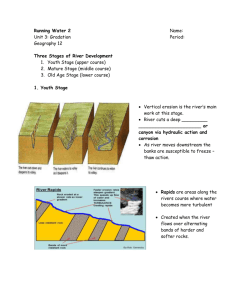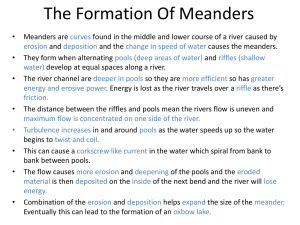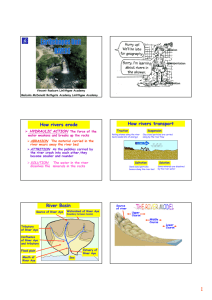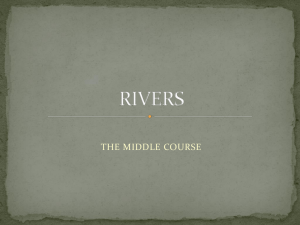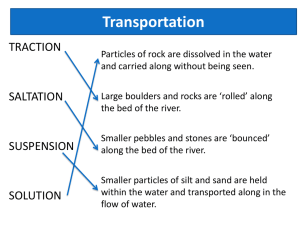Meanders and Motzkin Words
advertisement
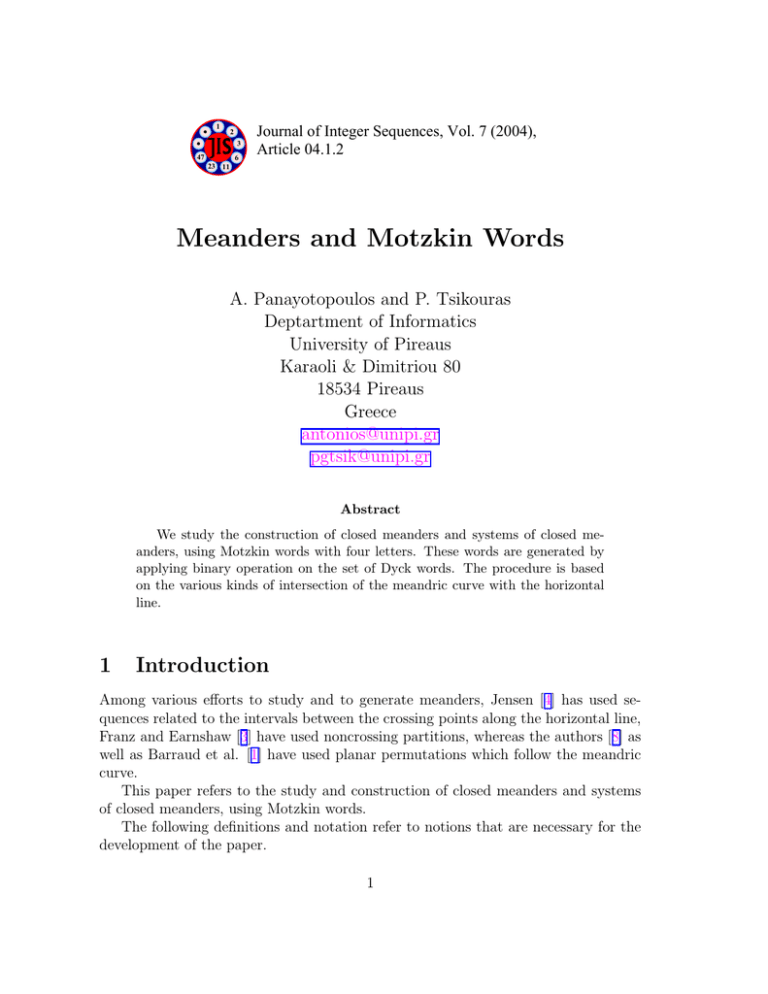
1
2
3
47
6
Journal of Integer Sequences, Vol. 7 (2004),
Article 04.1.2
23 11
Meanders and Motzkin Words
A. Panayotopoulos and P. Tsikouras
Deptartment of Informatics
University of Pireaus
Karaoli & Dimitriou 80
18534 Pireaus
Greece
antonios@unipi.gr
pgtsik@unipi.gr
Abstract
We study the construction of closed meanders and systems of closed meanders, using Motzkin words with four letters. These words are generated by
applying binary operation on the set of Dyck words. The procedure is based
on the various kinds of intersection of the meandric curve with the horizontal
line.
1
Introduction
Among various efforts to study and to generate meanders, Jensen [4] has used sequences related to the intervals between the crossing points along the horizontal line,
Franz and Earnshaw [3] have used noncrossing partitions, whereas the authors [8] as
well as Barraud et al. [1] have used planar permutations which follow the meandric
curve.
This paper refers to the study and construction of closed meanders and systems
of closed meanders, using Motzkin words.
The following definitions and notation refer to notions that are necessary for the
development of the paper.
1
A word u ∈ {a, ā}∗ is called a Dyck word if |u|a = |u|ā and for every factorization
u = pq we have |p|a ≥ |p|ā where |u|a , |p|a (resp. |u|ā , |p|ā ) denote the number of
occurrences of a (resp. ā) in the words u,p.
A word w ∈ {a, ā, x, y}∗ is called a Motzkin word if |w|a = |w|ā and for every
factorization w = pq we have |p|a ≥ |p|ā , or equivalently if the word obtained by
deleting every occurence of x, y from w is a Dyck word of {a, ā}∗ .
Let D2n denote the set of all Dyck words of length 2n. It¡ is¢well known that the
2n
1
(A000108); Panaycardinality of D2n equals to the Catalan number Cn = n+1
n
otopoulos and Sapounakis [6] have presented a construction of D2n .
Let u = u1 u2 · · · u2n with u ∈ D2n . Two indices i, j such that i < j, ui = a, uj = ā
are called conjugates with respect to u if j is the smallest element of {i+1, i+2, . . . , 2n}
for which the subword ui ui+1 · · · uj is a Dyck word.
There exists a bijection between D2n and N2n , since for each u ∈ D2n we can
determine its corresponding nested set Su ∈ N2n as follows : {i, j} ∈ Su if and only
if i, j are conjugate indices with respect to u.
For example, the nested set {{1, 6}, {2, 5}, {3, 4}, {7, 8}, {9, 10}} corresponds to
the Dyck word u = a a a ā ā ā a ā a ā.
We also recall that if we denote by dom S all the elements of N ∗ that belong to
some pair of a nested set of pairs S, we say that two nested set S1 , S2 are matching
if dom S1 = dom S2 and dom A = dom B, A ⊆ S1 , B ⊆ S2 imply that either
A = B = ∅ or dom A = dom S1 .
Furthermore, we call B ⊆ dom S complete if for every a ∈ B with {a, b} ∈ S, we
have b ∈ B. We write S/B = {{a, b} ∈ S : a ∈ B}. For every two nested sets S1 , S2
with dom S1 = dom S2 that are not matching, there exists a partition B1 , B2 , . . . , Bk
of dom S1 with Bi complete, such that the sets S1 /Bi , S2 /Bi , i ∈ [k] are matching;
we then call S1 , S2 k-matching [7].
Geometrically, if we draw two matching nested sets, one above and the other
underneath the horizontal axis, they form a simple, closed curve, whereas two kmatching nested sets create k such curves; (see Figures 1 and 2).
In section 2 we define the m-Motzkin words. To each such word corresponds a
pair of nested sets which are either matching or k-matching. The set of m-Motzkin
words is partitioned into classes of either two or four elements.
In section 3 we prove that there exists a bijection between the set of closed meanders and the set of m-Motzkin words which correspond to matching nested sets.
Using this bijection, we can generate closed meanders from m-Motzkin words.
In section 4 we extend the above results to systems of meanders and we present a
recursive generation of these systems.
2
2
m-Motzkin words
For every pair u = u1 u2 · · · u2n , u0 = u01 u02 · · · u02n of elements of D2n , we define u◦u0
to be the word w = w1 w2 · · · w2n , with
a, if ui = u0i = a;
ā, if ui = u0i = ā;
wi =
b, if ui = a, u0i = ā;
b̄, if ui = ā, u0i = a.
For example, from u = a a a ā ā ā a ā a ā and u0 = a ā a a ā a ā a ā ā we
obtain u◦u0 = a b a b̄ ā b̄ b b̄ b ā.
c2n = {w : w = u◦u0 , u, u0 ∈ D2n }.
We write W
c2n then w is a Motzkin word of {a, ā, b, b̄}∗ , with |w |b = |w |b̄ .
Proposition 2.1 If w ∈ W
Proof : Let I1 = {i ∈ [2n] : ui = u0i = a}, I2 = {i ∈ [2n] : ui = a, u0i = ā},
I3 = {i ∈ [2n] : ui = ā, u0i = a}, I4 = {i ∈ [2n] : ui = u0i = ā}.
Given that u, u0 ∈ D2n we have that: |I1 | + |I2 | = |I3 | + |I4 | and |I1 | + |I3 | = |I2 | + |I4 |;
so we get |I3 | = |I2 | and |I1 | = |I4 |, i.e. |w|b = |w|b̄ and |w|a = |w|ā .
Let now z be the word that we obtain by deleting every occurrence of b, b̄ in w.
Obviously |z|a = |w|a = |w|ā = |z|ā . In order to show that z is a Dyck word,
we must also have |s|a ≥ |s|ā , for every factorization z = st. This is true, since if
|s|a < |s|ā , for some such factorization, then for at least one of the words u, u0 we
would have a factorization pq with |p|a < |p|ā , contradicting the assumption that both
u and u0 are Dyck words.
¤
c2n meandric Motzkin words (or m-Motzkin words) of
We call the elements of W
length 2n.
c2n . From w we obtain two words r =
Let now w = w1 w2 · · · w2n , with w ∈ W
0
0 0
0
∗
r1 r2 · · · r2n , r = r1 r2 · · · r2n of {a, ā} , with
½
½
a, if wi = a or b;
a, if wi = a or b̄;
0
ri =
ri =
ā, if wi = ā or b̄,
ā, if wi = ā or b.
We call r and r 0 relatives of w.
Practically, in order to obtain r we change each occurrence of b, b̄ of w into a, ā
respectively, whereas in order to obtain r 0 we change b, b̄ into ā, a respectively.
c2n with w = u◦u0 , u, u0 ∈ D2n and let r , r 0 be its relaProposition 2.2 Let w ∈ W
0
tives. Then r = u and r = u 0 .
3
Proof : Let wi = a (resp. ā). Then ri = a = ui and ri0 = a = u0i (resp. ri = ā = ui
and ri0 = ā = u0i ). Let now wi = b (resp. b̄). Then ri = a = ui and ri0 = ā = u0i (resp.
ri = ā = ui and ri0 = a = u0i ).
So, we realize that in every case the elements of r and u as well as the elements
of r0 and u0 coincide, giving the required result.
¤
c2n that we have established,
From the bijection between the sets D2n × D2n and W
we obviously get the following relation :
c2n | = (Cn )2 .
|W
Notice that from the word u◦u0 we immediately obtain the word u0 ◦u, by interc2n it is actually enough
changing the letters b and b̄. So, in order to generate the set W
to construct half of its elements.
c2n two nested sets Sw , Sw0
So, by the above procedure we also create for each w ∈ W
on [2n] corresponding to the words r, r 0 ∈ D2n .
k
c2n for which Sw , Sw0
We denote with W2n (resp W2n
) the set of al the words w ∈ W
are matching (resp. k-matching).
For example, the word w = a b a b̄ ā b̄ b b̄ b ā is an m-Motzkin word, for which
we have r = a a a ā ā ā a ā a ā and r 0 = a ā a a ā a ā a ā ā.
The corresponding nested sets Sw = {{1, 6}, {2, 5}, {3, 4}, {7, 8}, {9, 10}} and
0
Sw = {{1, 2},{3, 10}, {4, 5}, {6, 7}, {8, 9}} are matching.
Similarly, the word w = a a b b̄ ā b̄ a ā b ā is a m-Motzkin word, for which we
have r = a a a ā ā ā a ā a ā and r 0 = a a ā a ā a a ā ā ā. The corresponding nested
sets
Sw = {{1, 6}, {2, 5}, {3, 4}, {7, 8}, {9, 10}}
and
Sw0 = {{1, 10}, {2, 3}, {4, 5}, {6, 9}, {7, 8}}
are 3-matching, with B1 = {1, 6, 9, 10}, B2 = {2, 3, 4, 5} and B3 = {7, 8}, thus
determining the matching nested sets :
Sw /B1 = {{1, 6}, {9, 10}}, Sw /B2 = {{2, 5}, {3, 4}}, Sw /B3 = {{7, 8}}
Sw0 /B1 = {{1, 10}, {6, 9}}, Sw0 /B2 = {{2, 3}, {4, 5}}, Sw0 /B3 = {{7, 8}}.
It is easy to obtain the following result.
k
Proposition 2.3 If w ∈ W2n
then there exist k subwords w j ∈ W2sj , j = 1, 2, . . . , k
with s1 + s2 + · · · + sk = n which can be recognized in w.
3
, we recognize the
For example, in the word w = a a b b̄ ā b̄ a ā b ā ∈ W10
1
2
subwords w = w1 w6 w9 w10 = a b̄ b ā ∈ W4 , w = w2 w3 w4 w5 = a b b̄ ā ∈ W4 and
w3 = w7 w8 = a ā ∈ W2 .
4
c2n :
We continue by introducing three internal operations in the set W
c2n , we define the words w \ , w− and w+ as follows:
For w ∈ W
wi\ = w̄2n+1−i
wi , if wi ∈ {a, ā};
−
b, if wi = b̄;
wi =
b̄, if wi = b,
¯ j = wj )
(where w̄
if w2n+1−i = a;
ā,
+
a,
if w2n+1−i = ā;
wi =
w2n+1−i , if w2n+1−i ∈ {b, b̄},
for every i ∈ [2n]. We may call these operations mirror, overturn and mirror-overturn
respectively.
For example, if w = a b a b̄ ā b̄ b b̄ b ā then w \ = a b̄ b b̄ b a b ā b̄ ā, w− =
a b̄ a b ā b b̄ b b̄ ā and w+ = a b b̄ b b̄ a b̄ ā b ā.
c2n , the words w \ , w− and w+ also belong to W
c2n .
It is obvious that for any w ∈ W
\
+
+
−
−
\
We have that w = w (resp. w = w) iff w = w (resp. w = w ) as well as that
w− 6= w and w+ 6= w \ . We thus obtain the following result.
c2n can be partitioned into classes of either two or four
Proposition 2.4 The set W
elements.
c2n : w2 = a, w2n−1 = ā} and B2n = {w ∈ W
c2n : w2 = b̄}. By
Let A2n = {w ∈ W
\
−
+
the previous properties of w , w and w we have the following proposition.
Proposition 2.5 i) If w ∈ A2n , then w \ , w− , w+ ∈ A2n .
ii) If w ∈
/ A2n , then at least one of the words w, w \ , w− , w+ belongs to B2n .
c2n it is enough
From the previous results it is clear that in order to construct W
to have A2n and B2n . In order now to generate each element w = u u0 of A2n (resp.
B2n ), it is enough to consider only the words u = u1 u2 · · · u2n , u0 = u01 u02 · · · u02n of
D2n with u2 = u02 = a and u2n−1 = u02n−1 = ā (resp. u2 = ā, u02 = a).
3
Meanders
We recall that a closed meander of order n is a closed self avoiding curve, crossing an
infinite horizontal line 2n times (A005315).
Let M2n be the set of all closed meanders of order n.
As opposed to previous papers [1], [8], the study of meanders will follow here the
order of the crossings of the horizontal line rather than the meandric curve itself.
It is clear that if µ ∈ M2n , the lines above (resp. underneath) the horizontal line
uniquely define a nested set Uµ (resp. Lµ ) on [2n] with Uµ , Lµ being matching and
5
Figure 1: A closed meander of order 5
conversely two matching nested sets Uµ and Lµ uniquely define the meander µ. This
allows us to actually identify a meander µ ∈ M2n to a pair (Uµ ,Lµ ) of nested sets of
[2n].
For example, for the closed meander µ of Figure 1 we have:
Uµ = {{1, 6}, {2, 5}, {3, 4}, {7, 8}, {9, 10}},
Lµ = {{1, 2}, {3, 10}, {4, 5}, {6, 7}, {8, 9}}.
To each meander of M2n corresponds a unique word of W2n . Intuitively, this correspondence becomes obvious when we assign the letters a, ā, b, b̄ to the various kinds of
intersection opening, closing, proceeding upwards, proceeding downwards respectively,
occurring along the horizontal line.
So, the word w = a b a b̄ ā b̄ b b̄ b ā corresponds to the closed meander of
Figure 1.
In order to develop formally these ideas we need the following result, obtained by
considering all the possible orderings for the elements i, j, h of the pairs {i, j} ∈ U µ
and {i, h} ∈ Lµ .
To every µ ∈ M2n corresponds a unique word w ∈ W2n , with
a, if i < j, h;
ā, if h, j < i;
wi =
b, if h < i < j;
b̄, if j < i < h,
where {i, j} ∈ Uµ , {i, h} ∈ Lµ .
So, from the nested sets Uµ , Lµ of the previous example we create again the word
w = a b a b̄ ā b̄ b b̄ b ā.
Conversely, to every word w ∈ W2n with Sw , Sw0 matching, corresponds a unique
meander µ ∈ M2n with Uµ = Sw , Lµ = Sw0 .
From the above, we have the following result.
Proposition 3.1 There exists a bijection between the sets M2n and W2n .
6
In order to determine Uµ and Lµ (and hence construct the meander µ ∈ M2n ) we
use the notion of conjugate indices of a Dyck word. So, given a word w ∈ W2n , we
create its relatives r, r 0 and we find the conjugate indices of these Dyck words, which
indicate the pairs of Uµ and Lµ respectively.
We recall that a pair {a, b} of a nested set S is called short pair if there is no
c ∈ dom S with either a < c < b or b < c < a, [7]. We have the following result.
Proposition 3.2 Each digram aā, ab̄, bā, bb̄ (resp. aā, ab, b̄ā, b̄b) of a word w ∈ W2n
corresponds to a short pair of Uµ (resp. Lµ ) in the associated meander µ.
So, we can also determine the meander µ ∈ M2n by repetitively contracting the
given word w ∈ W2n , using each time propositions 3.1 and 3.2.
So for w = a b a b̄ ā b̄ b b̄ b ā, we have:
w= a
b
a
b̄
ā
b̄
b
b̄
b
ā
1
2
3
4
5
6
7 8
9
10
a
b
ā
b̄
1
2
5
6
a
b̄
1 6
giving Uµ = {{1, 6}, {2, 5}, {3, 4}, {7, 8}, {9, 10}}.
Similarly, we have
w= a
b
a
b̄
ā
b̄
b
b̄
b
ā
1
2
3
4
5
6
7
8
9 10
a ā
3 10
giving Lµ = {{1, 2}, {3, 10}, {4, 5}, {6, 7}, {8, 9}}.
We thus finally get the meander µ of Figure 1 again.
Let µ ∈ M2n and w ∈ W2n its corresponding word. If we draw the meanders µ \ ,
µ− , µ+ that correspond to the words w \ , w− , w+ we realize that the above operations
define meanders symmetric to the meander µ that corresponds to w, with respect to
a vertical axis, to the horizontal line and to their intersection respectively.
It is easy to check that:
{i, j} ∈ Uµ \ iff {2n + 1 − i, 2n + 1 − j} ∈ Uµ ,
{i, j} ∈ Lµ \ , iff {2n + 1 − i, 2n + 1 − j} ∈ Lµ ,
U µ− = L µ , L µ− = U µ ,
U µ+ = L µ \ , L µ+ = U µ \ .
Hence, according to Proposition 2.4 we have the following result.
7
Proposition 3.3 The set M2n can be partitioned into classes of either two or four
elements.
4
Systems of meanders
We can extend the definition of closed meanders to systems of closed meanders with k
components (or k-meanders) by allowing configurations with k disconnected meanders
k
[5]. We will denote the set of all k-meanders of order n with M2n
, k ∈ {2, 3, . . . , n}.
Figure 2: A 3-meander of order 5
Obviously, like in the case of meanders, a k-meander ν also determines the corresponding nested sets Uν , Lν that are now k-matching.
For example, for the 3-meander ν of Figure 2 we have:
Uν = {{1, 6}, {2, 5}, {3, 4}, {7, 8}, {9, 10}}
Lν = {{1, 10}, {2, 3}, {4, 5}, {6, 9}, {7, 8}}.
We can still assign the letters a, ā, b, b̄ to the various kinds of intersection, thus
k
creating the corresponding word of W2n
.
So, the word w = a a b b̄ ā b̄ a ā b ā corresponds to the 3-meander of Figure 2.
k
k
It is easy to check that if we refer to meanders of M2n
instead of M2n , to W2n
instead of W2n and to k-matching instead of matching nested sets, we can apply
propositions 3.1, 3.2 and 3.3 to k-meanders.
k
So, similarly to proposition 3.1, there exists a bijection between the sets M 2n
and
k
k
k
W2n , i.e., to every ν ∈ M2n corresponds a unique word w ∈ W2n obtained by the
formula for wi .
k
Conversely, to every w ∈ W2n
with Sw , Sw0 k-matching, corresponds a unique
k
system of meanders ν ∈ M2n with Uν = Sw , Lν = Sw0 .
k
P. Di Francesco et al. [2] have given formulae for the cardinality of M2n
, for
n
n
k = n − 3, n − 2, n − 1, whereas for k = n we have |M2n | = C2n , given that W2n = D2n .
Similarly to proposition 3.2, we can now determine the system of meanders ν ∈
k
k
M2n from the word w ∈ W2n
.
8
Let now S be a member of the set N2n of the nested sets of pairs on [2n]; let
{a, d}, {b, c} ∈ S with a < b < c < d and such that for every {e, f } ∈ S with
e < b < f we have e ≤ a; then {a, d} (resp. {b, c}) is called father (resp. child ) of
{b, c} (resp. {a, d}). We call two elements {i, j}, {k, l} of S brothers if the have the
same father, or if they have no father.
We define two operations in N2n as follows:
If {b, c} and its father {a, d} belong to S ∈ N2n with a < b < c < d, then σ(S; a, b)
is the set obtained if we replace the pairs {a, d} and {b, c} with the pairs {a, b} and
{c, d}. It is obvious that σ(S; a, b) ∈ N2n and that {a, b} and {c, d} are brothers in
σ(S; a, b).
If {a, b}, {c, d} are brothers in S ∈ N2n , with a < b < c < d, then τ (S; a, c) is the
set obtained if we replace the pairs {a, b} and {c, d} with the pair {a, d} and {b, c}.
It is obvious that τ (S; a, c) ∈ N2n and that {a, d} is the father of {b, c} in τ (S; a, c).
The above definitions imply that if {a, d} is the father of {b, c} in the set S ∈ N 2n ,
then τ (σ(S; a, b); a, c) = S, whereas if {a, b}, {c, d} are brothers, then
σ(τ (S; a, c); a, b) = S.
We also have the following result.
k
Proposition 4.1 Let ν ∈ M2n
. If the father {a, d} and the child {b, c} (resp. the
brothers {a, b}, {c, d}) of Uν belong to the same component of ν then the set U =
σ(Uν ; a, b) (resp. U = τ (Uν ; a, c)) and Lν are (k + 1)-matching, thus defining a
k+1
meander ξ ∈ M2n
, whereas if they belong to different components of ν, then ξ belongs
k−1
to M2n
.
It is obvious that the above result still holds if we interchange L with U .
Proposition 4.1 is important since it enables us to recursively construct the sets
j
k
is known for some j ∈ [n − 1].
M2n
, k = j + 1, j + 2, . . . , n if the set M2n
For example, if µ ∈ M10 is the meander of Figure 1, we have that the sets Uν = Uµ
and Lν = τ (Lµ ; 6, 8) = {{1, 2}, {3, 10}, {4, 5}, {6, 9}, {7, 8}} determine a meander
2
; a second application of proposition 4.1 gives Uξ = Uν and
ν ∈ M10
Lξ = τ (Lν ; 1, 3) = {{1, 10}, {2, 3}, {4, 5}, {6, 9}, {7, 8}}
3
which determine the meander ξ ∈ M10
of Figure 2.
9
References
[1] J. Barraud, A. Panayotopoulos and P. Tsikouras, Properties of closed meanders,
Ars Combin. 67 (2003), 189–197.
[2] P. Di Francesco, O. Golinelli and E. Guitter, Meander, folding and arch statistics,
Math. Comput. Modelling 26 (1997), 97–147.
[3] R. O. W. Franz and B. A. Earnshaw, A constructive enumeration of meanders,
Ann. Comb. 6 (2002), 7–17.
[4] I. Jensen, A transfer matrix approach to the enumeration of plane meanders, J.
Phys. A 33 (2000), 5953–5963.
[5] S. K. Lando and A. K. Zvonkin, Plane and projective meanders, Theoret. Comput. Sci. 117 (1993), 227–241.
[6] A. Panayotopoulos and A. Sapounakis, On binary trees and Dyck paths, Math.
Inf. Sci. Hum. 131 (1995), 39–51.
[7] A. Panayotopoulos and P. Tsikouras, The multimatching property of nested sets,
Math. Sci. Hum. 149 (2000), 23–30.
[8] A. Panayotopoulos and P. Tsikouras, Properties of meanders, J. Combin. Math.
Combin. Comput., 46 (2003), 181–190.
2000 Mathematics Subject Classification: Primary 05A15; Secondary 05A18.
Keywords: Meanders, Dyck words, Catalan numbers, Motzkin words.
(Concerned with sequences A000108 and A005315.)
Received April 21 2003; revised version received January 20 2004. Published in
Journal of Integer Sequences, February 10 2004.
Return to Journal of Integer Sequences home page.
10
